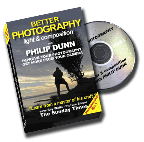
Living on the west coast of Scotland offers plenty of opportunities to photograph the effects of strong winds. Wind-bent trees make fantastic subjects, and my students often photograph them when we head off along the coast to take landscapes.
There are two basic methods of showing the wind actuality blowing – one is to use a fast shutter speed to freeze the action, and the other is to use a slow shutter speed to allow the movement to blur. Both can be highly effective when done well.
 The practical difficulties of actually putting the camera on a tripod and using a long exposure in strong winds can be hard to overcome. Camera shake is the biggest problem. Yes, even when the camera is on a tripod, it can still be subject to vibrations and movement when the wind whistles around it. A good heavy tripod is one answer, but failing that you might try weighting the tripod down with a plastic bag full of stones or sand. Anything will do. The last thing you want is for the camera and tripod to get blown over. Most tripods these days have a hook onto which you can hang a weighty bag.
The practical difficulties of actually putting the camera on a tripod and using a long exposure in strong winds can be hard to overcome. Camera shake is the biggest problem. Yes, even when the camera is on a tripod, it can still be subject to vibrations and movement when the wind whistles around it. A good heavy tripod is one answer, but failing that you might try weighting the tripod down with a plastic bag full of stones or sand. Anything will do. The last thing you want is for the camera and tripod to get blown over. Most tripods these days have a hook onto which you can hang a weighty bag.
For the picture of the waves, I used a 200mm lens to compress the perspective and pull the waves closer together. 1/350sec was used to freeze the action.
The shot of the wind-blown grass was done with the camera on a tripod – a heavy Benbo. A slow shutter speed of two seconds was used to show the movement in the grass as the wind blew through it. A wide angle lens was used to fill the foreground – because that is where the action is.
There are two basic methods of showing the wind actuality blowing – one is to use a fast shutter speed to freeze the action, and the other is to use a slow shutter speed to allow the movement to blur. Both can be highly effective when done well.
 The practical difficulties of actually putting the camera on a tripod and using a long exposure in strong winds can be hard to overcome. Camera shake is the biggest problem. Yes, even when the camera is on a tripod, it can still be subject to vibrations and movement when the wind whistles around it. A good heavy tripod is one answer, but failing that you might try weighting the tripod down with a plastic bag full of stones or sand. Anything will do. The last thing you want is for the camera and tripod to get blown over. Most tripods these days have a hook onto which you can hang a weighty bag.
The practical difficulties of actually putting the camera on a tripod and using a long exposure in strong winds can be hard to overcome. Camera shake is the biggest problem. Yes, even when the camera is on a tripod, it can still be subject to vibrations and movement when the wind whistles around it. A good heavy tripod is one answer, but failing that you might try weighting the tripod down with a plastic bag full of stones or sand. Anything will do. The last thing you want is for the camera and tripod to get blown over. Most tripods these days have a hook onto which you can hang a weighty bag.For the picture of the waves, I used a 200mm lens to compress the perspective and pull the waves closer together. 1/350sec was used to freeze the action.
The shot of the wind-blown grass was done with the camera on a tripod – a heavy Benbo. A slow shutter speed of two seconds was used to show the movement in the grass as the wind blew through it. A wide angle lens was used to fill the foreground – because that is where the action is.


No comments:
Post a Comment